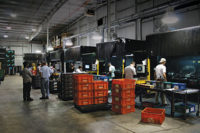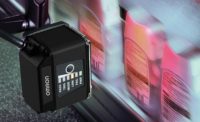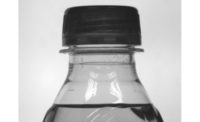Machine vision has thrived on the manufacturing floor, and is bringing new levels of insight to medical, security, and transportation applications, thanks in part by adopting technologies perfected for other markets.
High-speed cameras take on many forms, depending on their function. Today, high-speed CMOS cameras are found in many applications, including high frame-rate machine vision to ensure consistent quality in high-speed production; slow motion analysis, a vital tool to design, set up, and troubleshooting mechanized lines; lab applications; and slow-motion shots that are de rigueur in action movies, commercials, and sports broadcasts. Most cell phones can now capture high-speed footage with built-in CMOS cameras.
Machine vision cameras are produced in high numbers, which drive both sensor and lens development. The cameras are simple, composed only of optics, sensor, and interface. Image data is delivered from the camera over a standard interface to a frame grabber. Image content is analyzed for decision-making rather than for human viewing. Global shutters and short exposures minimize motion blur and distortion to facilitate analysis.
High-speed integrated cameras, while used in a wide range of applications, are not produced in numbers high enough to drive sensor or lens development. Most incorporate sensors developed for machine vision, or proprietary, small-production (expensive) sensors designed for a few high-end camera companies. The cameras may use industrial, SLR, or cinema lenses, and many require a PC or tethered processor for control functions, although most have complex embedded systems and can be operated autonomously.
High-speed integrated cameras commonly produce raw image data that may be transferred as sequences of discrete images, as well as video formats, which is important because frame-by-frame analysis is crucial for many applications. While recording, raw images are written to memory buffers within the camera, to be transferred to nonvolatile storage post-capture. Some newer cameras stream raw high-speed image data directly to nonvolatile storage. Advanced triggering functions are critical for capturing fleeting high-speed events and for precisely triggering groups of frame-synchronized cameras for 3D modeling and analysis.
Standard digital cinema and broadcast cameras are capable of producing most of the slow-motion shots seen in sports broadcasts and commercials. Special shots requiring higher frame rates utilize variants of high-speed cameras designed for testing and troubleshooting. For more artistic purposes, the video artist often will maximize exposure times to create a smooth video effect.
Consumer digital cameras and cell phone cameras enjoy economies of scale, benefitting from advanced technologies such as back-illuminated, stacked sensors that manage impressive light sensitivity despite their diminutive size. The “slo-mo” output of these cameras is generally highly-processed, interpolated compressed video for viewing on the device and sharing on the internet. Although capable of compelling video, motion distortion caused by rolling shutters make these cameras inappropriate for troubleshooting and motion analysis (see the fans image). Automatic control of focus and exposure, as well as built-in optics, limits their flexibility.
The high-speed world was very different in 2000. Cell phone cameras were primitive. One camera, based on a proprietary CMOS sensor, that recorded 1Mp at 1Kfps was considered a high-speed digital wonder, but it could not match the speed of rotary prism cameras (>10Kfps on 16mm film) or the image quality of pin-registered cameras that had been in use for decades. In 1988, Photo-Sonics won an Oscar for a 35mm pin-registered film camera that recorded 360fps!
High-speed film cameras were routinely found on military ranges for ballistics testing and at automotive test facilities for crash testing—often bolted onto vehicles smashed into barriers or other cars. But there was pressure for both the military and the auto makers to go digital:
High-speed film cameras were complicated mechanical devices subject to wear and routinely had to be rebuilt. Camera failure could easily compromise critical tests.
Film had to be developed off-site and digitized before the footage could be analyzed.
Tests had to be carefully choreographed since a 400’ reel of film would only yield a second of footage once the camera spooled up to speed.
Kodak announced it would discontinue the film favored for these cameras.
The military was pressured to “go digital” for environmental and logistical reasons.
Rotating prism cameras, much like rolling shutter sensors today, produced images with motion distortion: the top of each frame was exposed earlier in time than the bottom, so an object moving horizontally through the frame would appear to be bending backward.
Through the 1990s, several high-speed digital and analog video cameras were available. One that recorded 256 x 256 @ 4500fps was great for auto airbag testing and in labs where very high frame rates were needed. Another camera family was popular in automotive testing, on military tracking mounts, and in broadcast. These cameras sold for well over $100K. Less expensive high-speed cameras became available in the late 1990s. These new cameras, based on overclocked TI CCD sensors, recorded 512 x 480 at 250fps and 256 x 240 at 1Kfps. Selling for $30,000, these were used for production line troubleshooting and university research.
By the year 2000, machine vision was advancing rapidly but high speed was not yet an option. Two things were lacking: high-speed catalog sensors and a standard interface. But by the end of 2000 things changed. In October 2000, the Camera Link Interface Standard for Digital Cameras and Frame Grabbers was released. The interface could be configured according to bandwidth: 255MB/s for “Base”; 510MB/s “Medium”; and 680MB/s “Full.” In November 2000, the first high-speed CMOS catalog sensor was released. It was first implemented in high-speed integrated cameras and introduced into machine vision within a couple years.
From 2000 onward, the high-end high-speed camera companies competed in the automotive crash-test and military markets, each investing separately in proprietary CMOS sensors. These companies continue a game of leap-frog, investing in newer, faster, more sensitive proprietary CMOS sensors and coming out with faster and faster cameras. The newest cameras easily surpass the 10Kfps 16mm film cameras in both speed and imaging performance. The fastest can produce over a million frames per second. Camera Link has added the Deca configuration, 850 MB/s, and other fast interfaces such as CoaXPress and PCIe have emerged. New high-speed and high-resolution sensors are now available in machine vision cameras. These same sensors are finding their way into high-speed laboratory and troubleshooting cameras, giving them higher frame rates and resolutions, and opening up more applications for high-speed integrated cameras with catalog sensors.
Technologies such as back-illumination and stacked design are just beginning to become available in industrial sensors. As time goes on, machine vision cameras will continue driving demand for high-bandwidth interfaces and higher resolution, higher speed sensors, and will increasingly leverage technologies developed for high-production products such as consumer cameras and cell phones.







